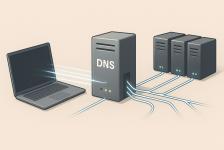You surely know it. You want to connect to a WiFi network on your mobile, tablet, or laptop, but the signal is weak. So you walk around the room to get that extra desired bar on the icon. However, such a solution is quite annoying and sometimes not even possible. What does the Mesh system have to do with this problem?

How to expand WiFi signal?
First, let's start from the beginning. There are several ways to achieve signal extension. The first and oldest method is using the so-called repeater. The name of this device could be translated as "repeater," and this term also accurately describes the principle of its operation. The signal from the main router is forwarded through the repeater on the same band.
Another option is a slightly more modern tool – the extender. We could call this a "range extender." The function is quite similar to that of a repeater. The advantage, however, is the use of multiple bands. A variant of the extender is the network extender, which is basically a secondary router using wired connectivity. Finally, the latest addition to the family of WiFi signal boosters is the WiFi Mesh system.
How does the Mesh system work?
Mesh systems are a relatively new concept and represent the most advanced way to ensure truly extensive coverage with a single WiFi network. Simply put, the principle relies on a network of several "routers." One main router also has several auxiliary units, which could be described as satellite elements.
All units are interconnected, equipped with omnidirectional antennas, and communicate with each other via the 2.4 GHz and 5 GHz bands. They can also use ethernet – which means a wired network. This system enables effective coverage of even significantly large areas with a strong signal from a single WiFi network.
Advantages of the Mesh system
The Mesh system offers extensive possibilities for using a wireless network in both home and corporate environments. It ensures high-quality and strong signals. In many cases, it allows you to avoid wired connectivity. Another advantage is that units communicate with each other – not just unidirectionally from the main unit to the auxiliary one. Therefore, the failure of one point does not jeopardize the system.
The setup and maintenance of such a network are very easy tasks that even a layman can handle. Configuration is straightforward, and the device itself chooses the optimal way to distribute the signal to ensure even and stable coverage.
When does it make sense to get a Mesh system?
Perhaps the only disadvantage of WiFi Mesh is the higher initial cost. Devices of this type started to appear only in 2016. We can hope for cost reduction in the future. Even now, however, the investment often pays off. You will especially appreciate the WiFi Mesh system if:
- You have a large apartment or house (or business premises)
- You have problems with signal propagation due to interference or obstacles
- You need to ensure a very strong and stable signal across the entire area
- You do not want to rely on a wired network
- You want a simple solution with no complicated configuration
What is DNS? Everything you need to know about its functionality and setup

When you type a website address into the browser, the correct page loads in an instant. This is managed by the DNS system, without which the internet as we know it would not exist at all. In this article, you will learn what DNS is, how it works, what types of records it contains, and why it is important for both speed and security of the connection.
How does fiber optic internet work and what do you need for its installation?

Fast and stable connection is a basic necessity in every household today. The solution is fiber optic internet, which works differently than regular cables and offers greater reliability to users. We'll explain how this technology works in practice, what it entails to run a fiber optic cable to your home, and what equipment you’ll need to keep everything running smoothly.
Cloud gaming – the end of consoles in sight?

Cloud gaming allows you to play games from anywhere without the need for expensive hardware. In this article, you'll learn how game streaming works, what advantages and limitations it brings, and which services are leading the way today. And most importantly: can it really threaten traditional consoles?
Chips under the skin and in the head. The future is closer than we think

Brain microchips already allow controlling a computer with mere thoughts. In the article, you will learn how they work, what they have brought to the first users, and what promises scientists and Elon Musk associate with them. Along with hopes, questions about safety, ethics, and where this technology might take us also arise.
What consumes the most data on mobile? YouTube, Spotify, Netflix and other apps under scrutiny

Mobile data usage can sometimes be unpleasantly surprising. The most are consumed by video streaming and music services – how much data does YouTube, Netflix or Spotify use? And what about other apps like social networks, maps or video calls? Check out the overview of the biggest data guzzlers and find out how to keep mobile data under control.
How to find out who is connected to your Wi-Fi – and can you easily disconnect them?

Is your internet slowing down or do you suspect that someone unauthorized is connected to your Wi-Fi? We advise you on how to find out who is connected to your Wi-Fi, and what to do if you find an intruder.